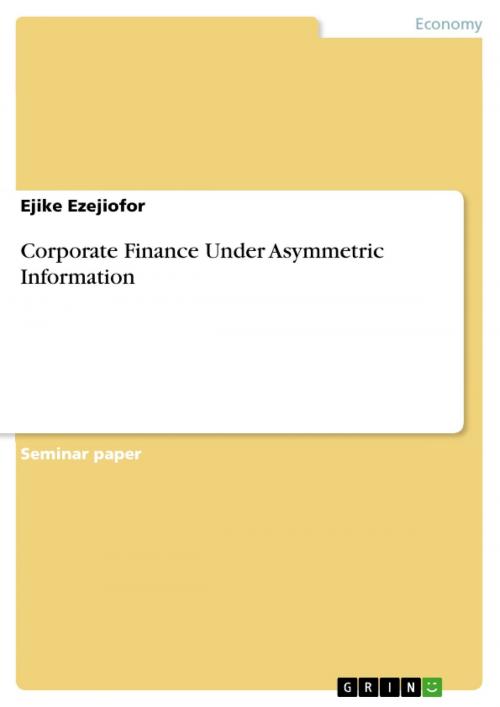| Author: | Ejike Ezejiofor | ISBN: | 9783656841449 |
| Publisher: | GRIN Verlag | Publication: | November 18, 2014 |
| Imprint: | GRIN Verlag | Language: | English |
| Author: | Ejike Ezejiofor |
| ISBN: | 9783656841449 |
| Publisher: | GRIN Verlag |
| Publication: | November 18, 2014 |
| Imprint: | GRIN Verlag |
| Language: | English |
Seminar paper from the year 2014 in the subject Economics - Finance, , course: MBA and Engineering, language: English, abstract: The specter of decreased economic activities, financial crisis, unbecoming ethical standards have in the recent past and fore going, characterized asymmetric information on corporate finance. The consequences normally have a ricochet effect and can be generally catastrophic to normal economic activities to mention the least. This paper considers scenario's where information asymmetry was prevalent or may have had its effects play out. The typical investor mindset and the opportunity cost associated with the preferred capital structure of the capitalizing process were mentioned. A basis for proper appreciation of the concept - Corporate finance under asymmetric information was initiated here, with a detailed explanation of corporate finance and its components, this was succeeded by a summary of scenarios were asymmetric information were prevalent and an intelligent look was also taken at asymmetric information between insiders and investors and the concomitant lemon problem, where the effects were carefully highlighted in a progression to the level of severity - Market breakdown and costly signaling. The fact that asymmetric information has been widely recognized as bad and generally viewed in a negative light must warrant it being viewed with a high level of seriousness. It is widely known that while lot of effort have been put into stemming the tides of the consequences of asymmetric information, a lot of effort too, have been dedicated to innovation and risk assessment, to capture the interest of investors, who have been affected by the consequences of asymmetric information. These may have formed a veritable platform for a recent paper by Pierre Barbaroux (2014), that elucidated the rise of innovation and innovative entrepreneurs based on the management of asymmetric information. An attempt has in any case, been made here to suggest efforts at marginalizing the negative impacts of asymmetric information and also remedies at reducing the far reaching impacts on the lenders and the aggregate economic activity in general.
Seminar paper from the year 2014 in the subject Economics - Finance, , course: MBA and Engineering, language: English, abstract: The specter of decreased economic activities, financial crisis, unbecoming ethical standards have in the recent past and fore going, characterized asymmetric information on corporate finance. The consequences normally have a ricochet effect and can be generally catastrophic to normal economic activities to mention the least. This paper considers scenario's where information asymmetry was prevalent or may have had its effects play out. The typical investor mindset and the opportunity cost associated with the preferred capital structure of the capitalizing process were mentioned. A basis for proper appreciation of the concept - Corporate finance under asymmetric information was initiated here, with a detailed explanation of corporate finance and its components, this was succeeded by a summary of scenarios were asymmetric information were prevalent and an intelligent look was also taken at asymmetric information between insiders and investors and the concomitant lemon problem, where the effects were carefully highlighted in a progression to the level of severity - Market breakdown and costly signaling. The fact that asymmetric information has been widely recognized as bad and generally viewed in a negative light must warrant it being viewed with a high level of seriousness. It is widely known that while lot of effort have been put into stemming the tides of the consequences of asymmetric information, a lot of effort too, have been dedicated to innovation and risk assessment, to capture the interest of investors, who have been affected by the consequences of asymmetric information. These may have formed a veritable platform for a recent paper by Pierre Barbaroux (2014), that elucidated the rise of innovation and innovative entrepreneurs based on the management of asymmetric information. An attempt has in any case, been made here to suggest efforts at marginalizing the negative impacts of asymmetric information and also remedies at reducing the far reaching impacts on the lenders and the aggregate economic activity in general.















